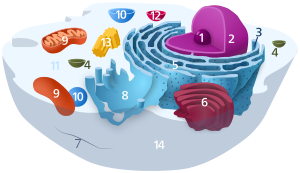
Back Vakuool AF فجوة عصارية Arabic Vakuol AZ واکوئل AZB Вакуоля BE Вакуола Bulgarian কোষ গহ্বর Bengali/Bangla Vakuola BS Vacúol Catalan Vacuole CEB
| Cell biology | |
|---|---|
| Animal cell diagram | |
 Components of a typical animal cell:
|


A vacuole (/ˈvækjuːoʊl/) is a membrane-bound organelle which is present in plant and fungal cells and some protist, animal, and bacterial cells.[1][2] Vacuoles are essentially enclosed compartments which are filled with water containing inorganic and organic molecules including enzymes in solution, though in certain cases they may contain solids which have been engulfed. Vacuoles are formed by the fusion of multiple membrane vesicles and are effectively just larger forms of these.[3] The organelle has no basic shape or size; its structure varies according to the requirements of the cell.
- ^ Venes D (2001). Taber's Cyclopedic Medical Dictionary (Twentieth ed.). Philadelphia: F.A. Davis Company. p. 2287. ISBN 0-9762548-3-2.
- ^ Schulz-Vogt HN (2006). "Vacuoles". Inclusions in Prokaryotes. Microbiology Monographs. Vol. 1. pp. 295–298. doi:10.1007/3-540-33774-1_10. ISBN 978-3-540-26205-3.
- ^ Brooker RJ, Widmaier EP, Graham LE, Stiling PD (2007). Biology (First ed.). New York: McGraw-Hill. pp. 79. ISBN 978-0-07-326807-1.